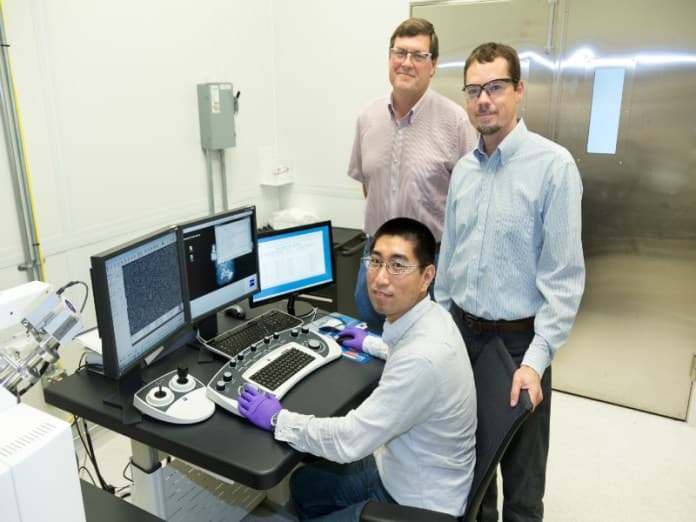Serendipitous Research Converts Carbon Dioxide Into Ethanol Using Copper And Carbon
In a rare breakthrough, scientists at Oak Ridge National Laboratory have stumbled upon an electrochemical process that uses tiny spikes of carbon and copper to turn carbon dioxide, a greenhouse gas, into ethanol. The accidental discovery involves nano fabrication and catalysis science. The team used a catalyst made of carbon, copper and nitrogen applying voltage to trigger a complicated chemical reaction which essentially reverses the combustion process.

ORNL’s Yang Song (seated), Dale Hensley (standing left) and Adam Rondinone examine a carbon nanospike sample with a scanning electron microscope.
With the help of the nanotechnology-based catalyst the solution of carbon dioxide dissolved in water, turned into ethanol with a yield of 63 percent. The product of ethanol was a surprise for researchers, as this type of electrochemical reaction often results in a mix of several different products in small amounts. The answer for the phenomenon however lay in the catalyst’s novelty of nanoscale structure, consisting of copper nanoparticles embedded in carbon spikes.
Given the technique’s reliance on low-cost materials and an ability to operate at room temperature in water, the approach could easily be scaled up for use in industrially relevant applications. It also entails zero energy cost, with the use of common place materials as carbon and copper. On energy storage, the process gives the option of storing excess power produced from varied power sources such as solar and the wind. The researchers intend to refine their approach to improve the overall production rate with further study of the catalyst’s properties and behaviour.
Source: <a href="https://www.ornl.gov/news/nano-spike-catalysts-convert-carbon-dioxide-directly-ethanol" target="_blank" rel="nofollow noopener noreferrer">Nano-spike catalysts convert carbon dioxide directly into ethanol | ORNL</a>

ORNL’s Yang Song (seated), Dale Hensley (standing left) and Adam Rondinone examine a carbon nanospike sample with a scanning electron microscope.
With the help of the nanotechnology-based catalyst the solution of carbon dioxide dissolved in water, turned into ethanol with a yield of 63 percent. The product of ethanol was a surprise for researchers, as this type of electrochemical reaction often results in a mix of several different products in small amounts. The answer for the phenomenon however lay in the catalyst’s novelty of nanoscale structure, consisting of copper nanoparticles embedded in carbon spikes.
Given the technique’s reliance on low-cost materials and an ability to operate at room temperature in water, the approach could easily be scaled up for use in industrially relevant applications. It also entails zero energy cost, with the use of common place materials as carbon and copper. On energy storage, the process gives the option of storing excess power produced from varied power sources such as solar and the wind. The researchers intend to refine their approach to improve the overall production rate with further study of the catalyst’s properties and behaviour.
Source: <a href="https://www.ornl.gov/news/nano-spike-catalysts-convert-carbon-dioxide-directly-ethanol" target="_blank" rel="nofollow noopener noreferrer">Nano-spike catalysts convert carbon dioxide directly into ethanol | ORNL</a>
0
